- SIGNAL FLAG
- Any of a number of straight-sided flags as well as various triangular and
squared-ended tapered pennants, of a generally simple, recognized design which,
when flown singly or together are used to transmit messages in an established
code, especially at sea – see
numeral flag and
numeral pennant (also
address group,
bunting tosser,
call sign hoist,
church pennant,
distinction pennant 1),
dressing ship,
flags 1),
International Code of Signal Flags,
flag lieutenant,
flag locker,
make her number,
Marryat’s code,
pendant number,
preparative,
repeating frigates,
signal hoist,
telegraph flag and
yeoman of signals.)
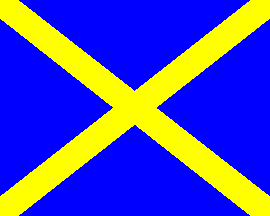
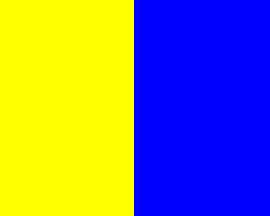
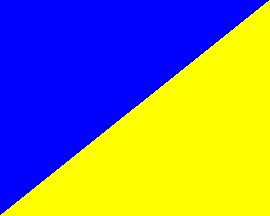
Number 3, Number 9 and the Finishing Pennant in
Popham's Code as amended in 1803
- SIGNAL HOIST (or GROUP)
- A group of signal flags hoisted together – a flag signal, flag hoist, a
hoist, a hoist of flags or signal group (see
also address group,
call sign hoist,
flag of distress 2),
International Code of Signal Flags,
make her number and
signal flag).
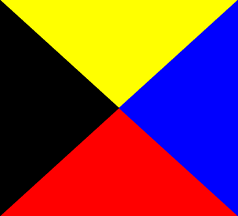
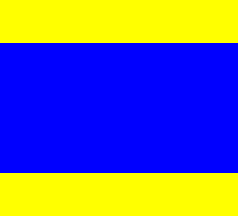

ZD2 (Zulu-Delta-2) in The International Code of Signal Flags or
"Please Report Me to Lloyds, London"
- SIGNIFER
- The bearer of a 'signum' (see signum below).
- SIGNUM (or SIGNA)
- 1) Generically and in the plural (signa) all the vexilla, flags and vexilloids used by the ancient Roman army
(see also draco, eagle 2),
flammula, vexilloid 2) and
vexillum).
- 2) Specifically and in the singular (signum) the vexilloid of a maniple, or subdivision of a Roman legion
(see also vexilloid 2)).
- 3) The similar vexilloids of auxiliary units.
Notes
a) A “maniple” was one-third of a cohort (which was itself one-tenth
of a legion) and in the first Century AD a standard maniple would consist of about 160 men.
b) Signum is the Latin for “sign” as semeion was in classical Greek
(see also semeion).
- SILKS
- See company colours.
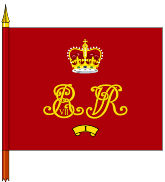
Silk/Company Colour, No 1 Company, 1st Battalion of The Irish Guards, UK (Graham Bartram)
- SIMPLE BICOLOUR
- See bicolour 2).
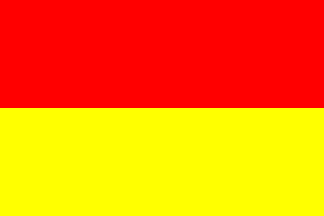
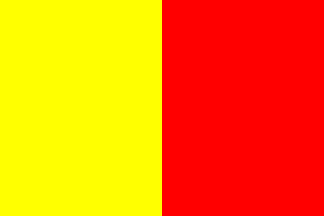
Civil Flag of Burgenland, Austria;
Flag of Andorra 1806–1866
- SIMPLE CHEVRON
- See chevron 1).

Flag of Herzele, Belgium
- SIMPLE PALL
- See pall.
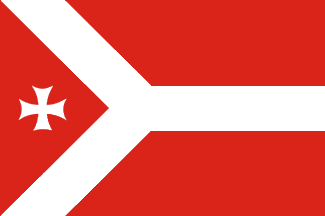
Flag of
Khashuri, Georgia
- SIMPLE PILE
- See pile.
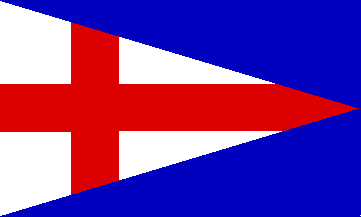
The Flag Institute 1971–2016, UK
- SIMPLE TRIANGLE
- See triangle 1).
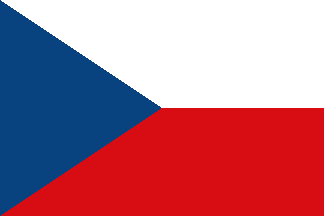
National Flag of Czechia
- SIMPLE TRIBAND
- See triband 2).
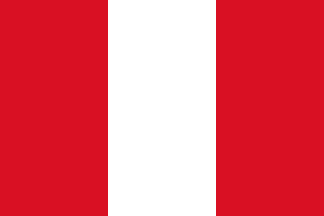

National Flag of Peru; National Flag of Austria
- SIMPLE TRICOLOUR
- See tricolour 2).
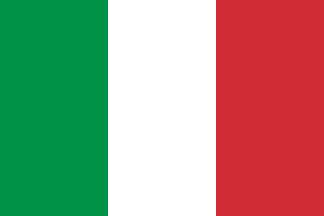
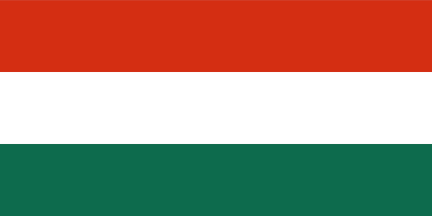
National Flag of Italy; Civil Ensign of Hungary
- SINGLE APPLIQUÉ
- A term that may be used when the appliqué technique is applied to one side of a flag,
and the field then cut out to provide visibility of the appliquéd section from the reverse –
see appliqué (also
double appliqué).
- SINISTER
- The heraldic term for the left hand side of a flag or shield from the point
of view of the bearer, or the right hand side from the point of view of an observer
(see also dexter).

- SINISTER EDGE
- 1. With regard to a shield see sinister above.
- 2. A term that may be used in describing the right hand facing edge of a banner or gonfalon
which is hung from a crossbar, and equivalent to the bottom edge of a conventionally hoisted flag –
the trailing edge (see also banner 2) and
gonfalon).

- SINISTER HOIST (HOISTED or HOISTING)
- A term used when the obverse of a flag is depicted (or is manufactured) with its hoist to the
observer’s right in the Arabic tradition – right-hoisted – but see
dexter hoist and
sinister above (also
hoist 1),
obverse and
reverse).
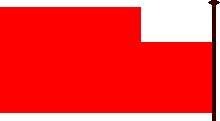
National Flag of Abu Dhabi
- SITTING
- The heraldic term for (a beast) sitting is sejant.
![[sitting]](../images/v/vx-no-09-12.gif)
Flag of Vegårshei, Norway
- SKULL AND CROSS-BONES
- See jolly roger.
![[skull and cross-bones]](../images/v/vx-pir_eeng.gif)
Pirate Flag: The Skull and Crossbones
- SLANTED DISPLAY DESIGN
- See flag for slanted display.
![[Pont-à-Celles]](../images/v/vxt-d1307.gif)
Flag of the Army For Slanted Display, Bolivia (fotw & CS)
- SLEDGE (or SLEDGING) FLAGS
- In UK and some other usage now largely obsolete, the flags (of varying design) that were
flown from the sledges of several polar expeditions in order to make them more visible from
a distance and for reasons of esprit de corps.
![[1875 North Pole expeditionary flag]](../images/v/vx-gb_ma75.gif)
Flag used by the 1875 Expedition to the North Pole
- SLEEVE
- 1) See heading.
- 2) Especially of an indoor flag, parade flag or military colour, a tube of
material at the hoist into which the staff is inserted – an open sleeve (see also
closed sleeve,
indoor flag,
parade flag,
colour 2),
nails,
tab and
staff 2)).
![[sleeve]](../images/v/vx-gb^28qc880.gif)
![[sleeve]](../images/v/vx-gb^grrc952.gif)
Queen’s Colour, The 28th Regiment of Foot
(North Gloucestershire Regiment), UK c1880;
Regimental Colour The Gloucester Regiment 1952, UK
Please note that the increasingly (but by no means entirely) obsolete
practice of fixing a flag to its pole or staff by a series of attached loops is almost certainly based
on the earlier use of ties – see loops
(also ring 4) and
ties).
- SLIPPED
- A heraldic term used in place of couped when applied to the stalks of trefoils,
flowers, leaves and sprigs of foliage – see
couped 2) (also
fructed,
leaved and
trefoil).
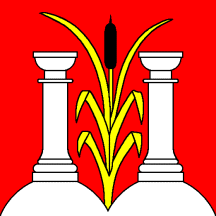
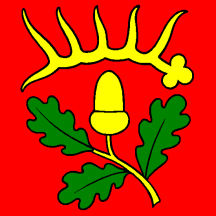
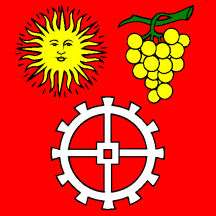
Flags of Sâles,
Flaach and
Mollens, Switzerland
Please note that a fruit or leaf etc. without a stalk is neither slipped nor couped.
- SMALLER (or SMALL) ARMS (or SMALLER/SMALL COAT OF ARMS)
- See lesser arms under arms.
small.gif)
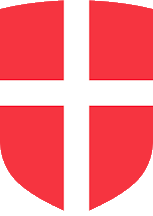
Smaller/Small Arms of Czechia and Tallinn, Estonia














![[sitting]](../images/v/vx-no-09-12.gif)
![[skull and cross-bones]](../images/v/vx-pir_eeng.gif)
![[1875 North Pole expeditionary flag]](../images/v/vx-gb_ma75.gif)
![[sleeve]](../images/v/vx-gb^28qc880.gif)
![[sleeve]](../images/v/vx-gb^grrc952.gif)










![[Pont-à-Celles]](../images/v/vxt-d1307.gif)
small.gif)
